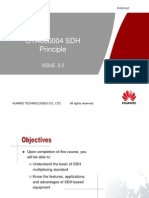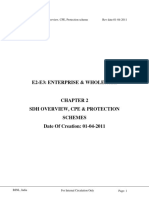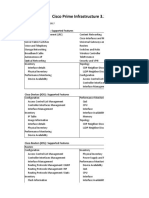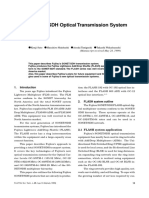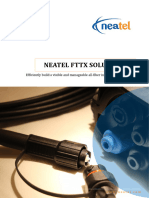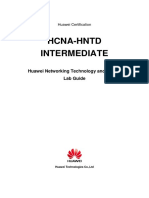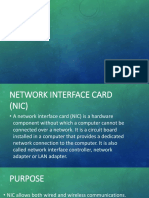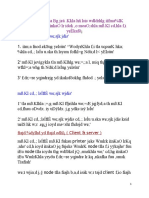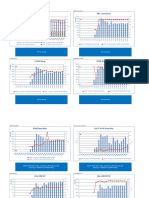Synchronous Digital Hierarchy
Frame Structure, Overheads and Pointers
Muhammad Zeeshan
�SDH Overview SDH Frame Structure SDH Multiplexing Overhead Pointers
�SDH OVERVIEW
�SDH Definition
Synchronous Digital Hierarchy (SDH) is a standard which is developed by the International Telecommunication Union (ITU) It is documented in standard G.707 and its extension G.708
It was developed to replace the Plesiochronous Digital
Hierarchy (PDH) system for transporting large amounts of telephone and data traffic and to allow for interoperability between equipment from different vendors
4
�Limitation of PDH
INTERFACES:
Electrical interfaces
There are only regional standards, instead of universal standards
Optical interfaces
No unified standards for optical line equipments, manufacturers develop equipment according to their own standards
�Standardization of optical interface
PDH: the electric interface is a standard interface, but the optical interface is not a standard interface
PDH Network
Standard electric interface
Manufacturer A Manufacturer B Manufacturer B
2Mbit/s or 34Mbit/s
Special PDH optical signal
�Limitations of PDH
MULTIPLEXING METHOD:
Asynchronous Multiplexing Code rate justification is required for matching and
accepting clock difference
The locations of the low-rate signals in high-rate signals are not regular nor fixed
�Limitations of PDH
Japanese Series
1.6Gb/s
North American Series
European Series
565Mb/s 4 139Mb/s 4 34Mb/s
4
400Mb/s 4 274Mb/s
100Mb/s
3 32Mb/s 5
6
3
45Mb/s 7 6.3Mb/s 4
4 8Mb/s
6.3Mb/s
4
3 24 64Kb/s 30
1.5Mb/s
2Mb/s
�Limitations of PDH
Adding and Dropping in PDH
Optical/Electrical
140/34 Mb/s
Electrical/Optical
34/140Mb/s
34/8 Mb/s
8/34 Mb/s
demultipexing
8/2 Mb/s 2/8 Mb/s
multiplexing
2 Mb/s
9
�Limitations of PDH
OPERATION & MAINTENANCE (OAM)
PDH signal frame structure has very few overhead bytes for Operation, Administration, and Maintenance (OAM)
NETWORK MANAGEMENT INTERFACE
No universal network management interface for PDH
network
10
�Advantages of SDH over PDH
INTERFACE
Electrical interfaces
SDH provides a set of standard rate levels----STM-N.
(N= 4n =1, 4, 16, 64).
The basic signal transmission structure level is STM-1, at a rate of 155Mb/s
Optical interfaces
Optical interfaces adopt universal standards. Line coding of SDH signals involves scrambling, instead of inserting redundancy codes
11
�Standardization of optical interface
SDH has standard optical interface
SDH Network
Standard optical interface
Manufacturer A Manufacturer B
Uniform STM-N optical signal
12
�Advantages of SDH over PDH
MULTIPLEXING METHOD
Low-rate SDH signals high-rate SDH
Signals via byte interleaved multiplexing method
PDH signals SDH
Synchronous multiplexing method and flexible mapping structure
13
�SDH Multiplexing
STM-N
N
STM-256
4
STM-64
4
STM-16
4
STM-4
4
STM-1
STM-1, 2, 34, 140 Mb/s
14
�SDH Signals and Data Rates
SDH Signals STM-1 STM-4 Bit rate(Mb/s) 155.520 or 155M 622.080 or 622M
STM-16 STM-64
2488.320 or 2.5G
9953.280 or 10G
STM: Synchronous Transport Module
SDH higher-rate signal (STM-4,16,64) is exactly 4 times that
of the lower-rate signal (STM-1)
15
�Adding and dropping in SDH
SDH: Economical and easy way for network!
155Mbit/s
Optical interface
ADM
155Mbit/s
Optical interface
2Mbit/s
Electric signal
16
�Advantages of SDH over PDH
OPERATION & MAINTENANCE
Abundant overhead bits are used for OAM. Unnecessary to add redundancy bits to monitor line
performance during line coding
COMPATIBILITY
SDH network and the existing PDH network can work
together
SDH network can accommodate the signals of other hierarchies such as ATM, FDDI, and Ethernet
17
�SDH FRAME STRUCTURE
�STM-N Frame Structure
For the convenience of signal analysis, the frame structures of the signals are often illustrated as block frame structures The frame structure of PDH signals, ATM signals and data packets of IP network are also block frames
The frame of E1 signals is a block frame of 1 Rows x
32 Columns consisting of 32 Bytes
19
�STM-1 Frame Structure
125 s
1 3 4 5
RSOH AU-PTR MSOH
9 Rows
P O H
STM-N payload (including POH)
9
RSOH: Regenerator Section Overhead MSOH: Multiplex Section Overhead POH: Path Overhead AUPTR: Administrative Unit Pointer
20
261 270 Columns
�STM-N Frame Structure
125 s
1 3 4 5
RSOH AU-PTR MSOH
9 Rows
P O H
STM-N payload (including POH)
9N
RSOH: Regenerator Section Overhead MSOH: Multiplex Section Overhead POH: Path Overhead AUPTR: Administrative Unit Pointer
21
261N 270N Columns
�SDH Frame Structure - ANATOMY
Transmission rate of single byte of STM-N frame:
STM-N frame contains 2430xN Bytes and each frame is transmitted every 125 s
That means a given byte is transmitted 8000 times a second
Transmission rate of a single byte:
8000 x 8 = 64 Kbps
Transmission rate of a STM-1 frame:
9 rows x 270 columns x 8000 frames/s x 8 bits = 15,55,20,000 bps = 155.52 Mbps
22
�1st Byte
STM-1 Frame Transmission
1 271 270 540
2430th Byte
2161 Transmission Direction
1st Byte of STM frame # 1
2430
Transmission Mode: Byte-by-Byte, From Left to right & top to bottom
Last byte of STM frame # 1
STM-1 Frame # 1
1st Byte STM Frame # 2
23
�SDH Frame Structure
Payload area for services transmission in STM-N 2M, 34M, and 140M signals are packed and carried in the payload of STM-N frame over SDH network Path Overhead (POH) after packing low rate signals, POH is added for OAM of every frame
24
�SDH Frame Structure
Section Overhead (SOH) monitors the whole STMN frame
Regenerator Section Overhead (RSOH) monitors the
whole STM-N frame.
Multiplex Section Overhead (MSOH) monitors each STM-1 of the STM-N frame.
RSOH, MSOH, and POH compose the integrated
monitoring system of SDH.
25
�SDH Network NE Types
Terminal Multiplexer (TM) Add/Drop Multiplexer (ADM) Regenerator (REG)
26
�Regenerator
Regenerator has the job of regenerating the clock and amplitude relationships of the incoming data signals that have attenuated and distorted by dispersion
The regenerator replaces the RSOH bytes before re-transmitting
the signal
STM-N
Regenerator
STM-N
27
�Terminal Multiplexer
Terminal multiplexers are used to combine
plesiochronous and synchronous input signals into higher bit rate STM-N signals
PDH SDH
Terminal Multiplexer
STM-N
28
�Add / Drop Multiplexer
PDH and SDH signals can be extracted from or inserted into high speed SDH bit streams by means of ADMs
STM-N Towards other NEs STM-N Towards other NEs
Add / Drop Multiplexer
ATM
IP
SDH
PDH
Customers
29
�Sections in the SDH Network
There are three sections in the SDH
Path Multiplex Section Regenerator Section
The overheads are always generated at the beginning of a section and only evaluated at the end of a section
Path
Multiplex Section Terminal Multiplexer REG Add/Drop Multiplexer REG Terminal Multiplexer
REG
Regenerator Section
30
�Overhead Layer
POH MSOH RSOH
Payload Path Section Optical
Optical Fiber Cable
Payload Path Section Optical
31
�How to understand SOH and POH?
Both SOH and POH are OAM bytes added to ensure correct and flexible transmission of signals SOH and POH are used in different layers to supervise and administrate the signals. RSOH and MSOH are used in RS and MS separately, but HPOH and LPOH are used for VC-3/VC4 and VC12
LPOH----used to supervise small package (VC-12) HPOH----used to supervise big package (VC-3 / VC-4) MSOH----used to supervise the carriage(STM-1) of the truck RSOH----used to supervise the motorcade formed by trucks (STM-4/16/64)
32
�SDH Frame Structure
AU Pointer (AU-PTR)
Used for alignment of lower rate signals in the payload of STM-N frame to accurately locate the payload AU-PTR is added in transmitting end, when the signal is packed into the payload of STM-N frame At receiving end, the low rate signal is dropped from STM-N frame according to the AU-PTR value
Low-rate signals in the STM frame are arranged obeying some rules byte interleave; so only have to locate the first low-rate signal in the STM frame
33
�SDH MULTIPLEXING
�SDH Multiplexing
SDH Multiplexing includes:
Low to high rate SDH signals (STM-1 STM-N) PDH to SDH signals (2M, 34M & 140M STM-N) Other hierarchy signals to SDH Signals (ATM STM-N)
35
�SDH Multiplexing Structure
1 STM-64 1 STM-16 STM-4 1
Mapping
AUG-64 4
AUG-16 4 AUG-4 4 AUG-1
Aligning Multiplexing Pointer processing
1
STM-1
1 AU-4
3 VC-4 C-4 139264 kbit/s
TUG-3 7
TU-3
VC-3
C-3
34368 kbit/s
TUG-2 TU-12
VC-12
C-12
2048 kbit/s
36
�Mapping, Aligning and Multiplexing
Low-rate tributaries are multiplexed into STM-N signals through three procedures:
Mapping
Aligning
Multiplexing.
MAPPING
SDH mapping is a procedure by which tributaries are adapted into virtual containers at the boundary of an SDH network, for example, E1 into VC-12, E3 into VC-3, E4 into VC-4.
ALIGNING
SDH aligning is a procedure by which the frame-offset information is incorporated into the tributary unit, by adding a pointer The pointer value constantly locates the start point of the VC frame within the payload, so that the receiving end can correctly separate the corresponding VC
MULTIPLEXING
SDH multiplexing is the procedure by which multiple lower order path layer signals are adapted into a higher order path
37
�Multiplexing Structure
C: Container VC: Virtual Container TU: Tributary Unit TUG: Tributary Unit Group AU: Administrative Unit AUG: Administrative Unit Group
38
�2 Mb Signal Mapping Procedure
Rate Adaptation 1 4 1
1 Byte Path Overhead (POH)
VC12
POH
4 1
C12
2 Mbps Signal
9
C12
9
125 s
MAPPING
125 s
C-12 Size: (9 Rows x 4 Columns) 2 = 34 Bytes C-12 Frame Duration = 125 s
There can be four different POH bytes for one C-12 V5, J2, N2, K4
VC-12 = C-12 + (1 Byte POH)
VC-12 Size: (9 Rows x 4 Columns) 1 = 35 Bytes VC-12 Frame Duration = 125 s
39
�2 Mb Signal Mapping Procedure
1
VC12
POH
1 Byte Tributary Unit Pointer (TU-PTR) 4 1
TU12
POH
Multiplexing x3 4 1
TUG2
T U 12 T U 12 T U 12
12 1
C12
9
C12
PTR
125 s
ALIGNING
125 s
MULTIPLEXING
125 s
TU-12 = VC-12 + (1 Byte TU-PTR)
TU-12 Size : (9 Rows x 12 Columns) = 36 Bytes
TUG-2 = TU-12 + TU-12 + TU-12 TUG-2 size: (9 Rows x 12 Columns) = 108 Bytes TU-12 and TUG-2 Frame Duration = 125 s
40
�2 Mb Signal Mapping Procedure
Multiplexing x7 12
1 T U 12 T U 12 T U 12 9 1 T U R R G 2
TUG2
TUG3
T U G 2 T U G 2 T U G 2 T U G 2 T U G 2
86 T U G 2 9 1
125 s
125 s
TUG-3 Size = (TUG-2) x 7 + R (2 Columns)
TUG-3 Frame Duration = 125 s
41
�2 Mb Signal Mapping Procedure
Multiplexing x3
86 1 P O R R H 9 1
TUG3
VC4
T U G 3 T U G 3 T U G 3
261 1
125 s
125 s
VC-4 = TUG-3 + TUG-3 + TUG-3 + R (2 Columns) + POH (1 Column) VC-4 Frame Size = 9 Rows x 261 Columns = 2349 Bytes VC-4 Frame Duration = 125 s
42
�2 Mb Signal Mapping Procedure
AU-PTR Multiplexing x1 RSOH and MSOH
1 1
VC4
261 1
AU4
270 1
AUG
270 1
STM-1
270
RSOH AU-PTR AU-PTR AU-PTR
VC4
9
VC4
9
VC4
125 s
MSOH
125 s
125 s
125 s
2 Mb Multiplexing Route
2 Mb C-12 VC-12 TU-12 TG-2 TG-3 VC-4 AU-4 AUG STM-1
43
�34 Mb Signal Mapping Procedure
Rate Adaptation 1 1 84 Path Overhead (POH) 1 1
VC3
C3
125 s
85
P O
C3
34 Mbps Signal
9 9
125 s
C-3 Frame Size: 9 rows x 84 columns = 756 Bytes C-3 Frame Duration: 125 s VC-3 = C-3 + (POH) POH = 9 Rows x 1 Column = 9 Byte
VC-3 Frame Size: 9 Rows x 85 Columns = 765 Bytes
VC-3 Frame Duration: 125 s
44
�34 Mb Signal Mapping Procedure
Tributary Unit Pointer 1
H1 H2 H3
TU3
VC3
Fixed Stuffing Bits 86 1 1
H1 H2 H3
TUG3
TU3
R
86 1
125 s
STUFFING
125 s
TU-3 = VC-3 + TU-PTR TUG-3 = TU-3 + R
Bits) (Fixed Stuffing
TU-PTR = 3 Byte Pointer (H1, H2 and H3)
R (Fixed Stuffing Bits) = 6 Bytes (Fixed Stuffing Bits)
TU-3 and TUG-3 Frame Duration = 125 s
45
�34 Mb Signal Mapping Procedure
Multiplexing 1
H1 H2 H3
TUG3
TU3
R
86
x3
VC4
T U G T U G T
261 1
U G
OR R
9
3
9
125 s
125 s
VC-4 = TUG-3 + TUG-3 + TUG-3 + R (2 Columns) + POH (1 Column)
VC-4 Frame Size = 9 Rows x 261 Columns = 2349 Bytes
VC-4 Frame Duration = 125 s
46
�34 Mb Signal Mapping Procedure
AU-PTR Multiplexing x1 RSOH and MSOH
1 1
VC4
261 1
AU4
270 1
AUG
270 1
STM-1
270
RSOH AU-PTR AU-PTR AU-PTR
VC4
9
VC4
9
VC4
125 s
MSOH
125 s
125 s
125 s
34 Mb Multiplexing Route
34 Mb C-3 VC-3 TU-3 TUG-3 VC-4 AU-4 AUG STM-1
47
�140 Mb Signal Mapping Procedure
Rate Adaptation 1 1 260 Path Overhead (POH) 1 1
VC4
C4
125 s
261
P O H
C4
140 Mbps Signal
9 9
125 s
Rate Adaptation: The process of Bit stuffing, to account for different clock rates of the signals coming from different sources C-4 Frame Size: 9 rows x 260 columns = 2340 Bytes
C-4 Frame Duration: 125 s
VC-4 = C-4 + (POH) POH = 9 Rows x 1 Column = 9 Byte
VC-4 Frame Size: 9 Rows x 261 Columns = 2349 Bytes
48
�140 Mb Signal Mapping Procedure
AU-PTR
1 1 4
AU4
9 10
Multiplexing x 1 270 1 1
AUG4
9 10 270
AU-PTR
VC4
9
AU4
125 s
125 s
AU-PTR: A 9 byte pointer is inserted at Row No 4 AU4 Size: (1x9)+(9x261) = 2358 Bytes AU-4 and AUG Frame Duration: 125 s
In case of 140 Mb signal mapping in STM-1, AU-4 and AUG are identical
49
�140 Mb Signal Mapping Procedure
RSOH and MSOH
AUG4
AU4
125 s
270 1 1 3
AUG4
9 10 270 1 1 270
RSOH
AU4
5
STM-1
9
MSOH
9
125 s
125 s
RSOH Size: 3 Rows x 9 Columns = 27 Bytes MSOH Size: 5 Rows x 9 Columns = 45 Bytes STM-1 Size: 9 Rows x 270 Columns = 2430 Bytes STM-1 Frame Size: 125 s
50
�OVERHEADS
�Overhead Bytes
STM-1 Frame Structure
OVERHEAD
1
RSOH
AU-PTR
P O
MSOH
9
1
270
PAYLOAD
52
�Section Overhead (SOH)
Overhead in SDH frame structure are classified as:
Section Overhead SOH Path Overhead POH
SOH is further divided into RSOH and MSOH
RSOH can be accessed in the regenerator or at the terminal
equipment
MSOH can be processed at the terminal equipment
53
�Regenerator Section Overhead RSOH
A1
A1
A1
A2
A2
A2
J0
B1
D1
E1
D2
F1
D3
: Media dependent bytes
X: Bytes reserved for national use
54
�A1 and A2 Bytes
Frame Alignment (Framing) Bytes Indicate the beginning of the STM-N frame A1 = F6H (11110110), A2 = 28H (00101000) In STM-N: (3XN) A1 bytes, (3XN) A2 bytes
stream
STM-N
Frame # 1
STM-N
Frame # 2
STM-N
Frame # 3
STM-N
Frame # 4
STM-N
Frame # 5
STM-N
Frame # 6
Finding frame head
�A1 and A2 Bytes
Framing
Find A1,A2 Y
N 625 s
OOF
over 3ms
LOF
Next process
AIS
OOF: Out Of Frame
LOF: Loss Of Frame
AIS: Alarm Indication Signal
�Regenerator Section Trace J0 Byte
Regenerator Section Trace Byte: J0
Its used to transmit repetitively a Section Access Point Identifier so that a section receiver can verify its continued
connection to the intended transmitter
Another usage of the J0 byte is that J0 byte in each STM-N frame is defined as an STM identifier C1 i.e., to identify
individual STM-1 inside a multiplexed STM-N
Within the domain of a single operator, this byte may use any character
57
�B1 Byte
Bit interleaved Parity Code (BIP-8) Byte A parity code (even parity), used to check the transmission errors over the RS
BIP-8
A1 A2 A3 A4
00110011 11001100 10101010 00001111
STM-N
Tx
Calculate B1 of STM-N #1 Place the result of BIP in B1 of STM-N #2 Verify B1 B2
Rx
1#STM-N 2#STM-N
2#STM-N
B 01011010
1#STM-N
�F1 Byte
User Channel Byte: F1
Provides a 64 kb/s data/voice channel for special maintenance purposes.
TM
REG
F1
ADM
TM
59
�E1 and E2 Bytes
Orderwire Bytes: Provides one 64 kbps each for voice communication E1: RS Orderwire Byte RSOH orderwire message E2: MS Orderwire Byte MSOH orderwire message
Digital telephone channel E1-RS, E2-MS
TM
ADM
E1 and E2
REG
TM
�Quiz
If only E2 byte is used as order wire byte, then order wire voice communication is provided between:
A and B B and C C and D
61
�Quiz
If only E1 byte is used as order wire byte, then order wire voice communication is provided between:
A and B B and C C and D A and D
62
�D1 ~ D12 Bytes
Data Communications Channels (DCC) Bytes Message-based Channel for OAM between NEs and NMS RS-DCC D1 ~ D3 192 kbit/s (3X64 kbit/s) MS-DCC D4 ~ D12 576 kbit/s (9X64kbit/s)
NE
NE DCC channel
NE
NE
TMN
OAM Information: Control, Maintenance, Remote Provisioning, Monitoring (Alarm & Performance), Administration
�Multiplex Section Overhead MSOH
B2 D4 D7
D10
B2
B2
K1 D5 D8
D11
K2 D6 D9
D12
S1
M1 E2
X: Bytes reserved for national use
64
�B2 Bytes
The B1 byte monitors the transmission error of the complete STM-N frame signal The B2 bytes monitor the error performance status for each STM-1 frame within the STM-N frame There are N*3 B2 bytes in an STM-N frame with every three B2 bytes corresponding to an STM-1 frame
65
�B2 Bytes
B2 Byte Principle
At transmitting end, the BIP-Nx24 is computed over all bits of the STMN frame except for the first three rows of SOH, and the result is placed in 3 bytes B2 of the preceding frame before scrambling. At receiving end, the BIP- Nx24 is computed over all bits of the frame except for the first three rows of SOH, and then Exclusive OR with the B2 bytes of the later arrived frame. If the value of Exclusive OR operation is zero, there is no bit block error. Any mismatch in result indicates transmission errors.
11001100 11001100 11001100 01011101 01011101 01011101
For example BIP-N24 is computed over a frame of signal composed of 9 bytes.
BIP24
11110000 11110000 11110000 01100001 01100001 01100001
66
�K1 and K2 (b1 ~ b5)
Automatic Protection Switching (APS) channel bytes Used for transmitting APS signaling to implement equipment self-healing function The K1 byte and K2(b1~b5) are used for automatic switchover to a standby path
67
�K1 and K2 (b1 ~ b5)
NE-B detects a transmission error on the line and informs NE-A via K1 byte to switchover NE-A switches to the standby channel NE-A via K2 byte indicates the switchover in NE-B NE-B switches to the standby channel
NE-A
Working path
NE-B
K2
Standby path
Working path
K1
Standby path
68
�S1 Byte
Synchronization Status Message Byte (SSMB) This byte is used for synchronization of network Bits 5 to 8 of S1 byte indicate the quality of the incoming clock The smaller the value of S1 (b5-b8), the higher the level of clock quality This helps to determine whether or not to switch the clock source, i.e. switch to higher quality clock source bits 5 ~ 8 Meaning
0000 0010 0100 1000 1011 1111 Quality unknown (existing sync. Network) G.811 PRC G.812 transit G.812 local G.813 SETS (Synchronous Equipment Timing Clock)
Do not use for sync.
�M1 Byte
Multiplex Section Remote Error IndicationMS-REIByte This byte is used to report back the number of error blocks detected by the receiver by evaluating three B2 bytes Tx generate corresponding performance event MS-REI
Evaluate B2 and detect bit errors
Traffic
B2 B2 B2
Tx
Rx
M1
MS-REI
Generate MS-REI
Report no. of errors detected
�Path Overheads
1 2 3 4 5 6 7 8 9 10 1 2 3 4 5 6 7 8 9
J1 B3 C2
VC-n Path Trace Byte
Path BIP-8 Path Signal Label
G1
F2
Path Status
Path User Channel
H4
F3 K3 N1
TU Multiframe Indication
Path User Channel
AP Switching Network Operator
Higher Order Path Overhead
�Path Signal Label : C2 Byte
C2 byte is used to indicate the type and composition of the VC-4 tributary information
72
�Path Status : G1 Byte
Path status byte This byte is used to report back the fault from path sink to path source and is set in the POH of the opposite direction
HP-REI
1 2 3 4
HP-RDI
5 6
Reserved
7 8
HP-REI: High order Path Remote Error Indication
HP-RDI: High order Path Remote Defect Indication
73
�HP-REI and HP-RDI
Higher order Path Remote Error Indication
The SDH NE (sink end) checks B3 bytes If error blocks are detected, the number of error blocks detected is sent to the remote terminal in HP-REI signal
Higher order Path Remote Defect Indication
The SDH NE (sink end) checks J1 and C2 bytes If J1 and C2 fail to be consistent, HP-TIM (Higher order path Trace Identifier Mismatch) and HP-SLM (Higher order Path Signal Label Mismatch) alarms are generated HP-RDI is sent back to the remote end
74
�Multiframe Indication : H4 Byte
This byte indicates the frame label for a multiframe in the next VC-4 payload The value of this byte ranges from 00H to 03H
75
�Path Overheads
Low Order Path Overhead 1 1 4
V5
J2
N2
K4
VC-12
VC-12
VC-12
VC-12
500s VC-12 multiframe
�Path Status and Signal Label : V5 Byte
BIP-2
1 2
LP-REI LP-RFI
3 4 5
Signal Label
6 7
LP-RDI
8
BIP-2
Parity code of VC-12
LP-REI
Low order Path Remote Error Indication
LP-REI is set to "1" and returned to the opposite direction if one or more errors are detected via BIP-2
LP-RFI
Low order Path Remote Failure Indication If a defect condition persists beyond the maximum allowed time, it becomes a failure, then LP-RFI is set to "1" and sent back to the source
Signal Label
Indicates type and composition of VC-12 tributary information
LP-RDI
Low order Path Remote Defect Indication If sink end detects a TU-12 AIS, it sets LP-RDI to "1" and sends back to the source
77
�POINTERS
�Pointers
Pointers
AU-PTR
TU-PTR
�AU-PTR
1
RSOH
AU-PTR
MSOH
�AU-PTR
H1
1
Y
2
Y
3
H2
4
F
5
F
6
H3
7
H3
8
H3
9
Y: Fixed value 1001SS11 F: Fixed value 11111111 H3: Additional transmission capacity during negative
justification
H1 and H2: Pointer value is contained in the last ten bits of H1
and H2
81
�AU-PTR
H1 and H2
N N N N S S I D I D I D I D I D
N: New data flag bits
A notification to the receiver about the change in pointer value and pointer justification operation
AU/TU type:
For AU-4 and TU-3, SS=10
I/D: Increment/Decrement bits
D bits are inverted to decrement next AU-PTR address (-ve justification)
I bits are inverted to increment next AU-PTR address (+ve justification)
82
�TU-PTR
The tributary unit pointer is used to indicate the specific location of the first byte (V5) of the VC-12 within the TU-12 payload
83
�TU-PTR
500s VC-12 multiframe
VC-12
VC-12
VC-12
VC-12
V1
V2
V3
V4
TU POINTERS
�THANK YOU






















